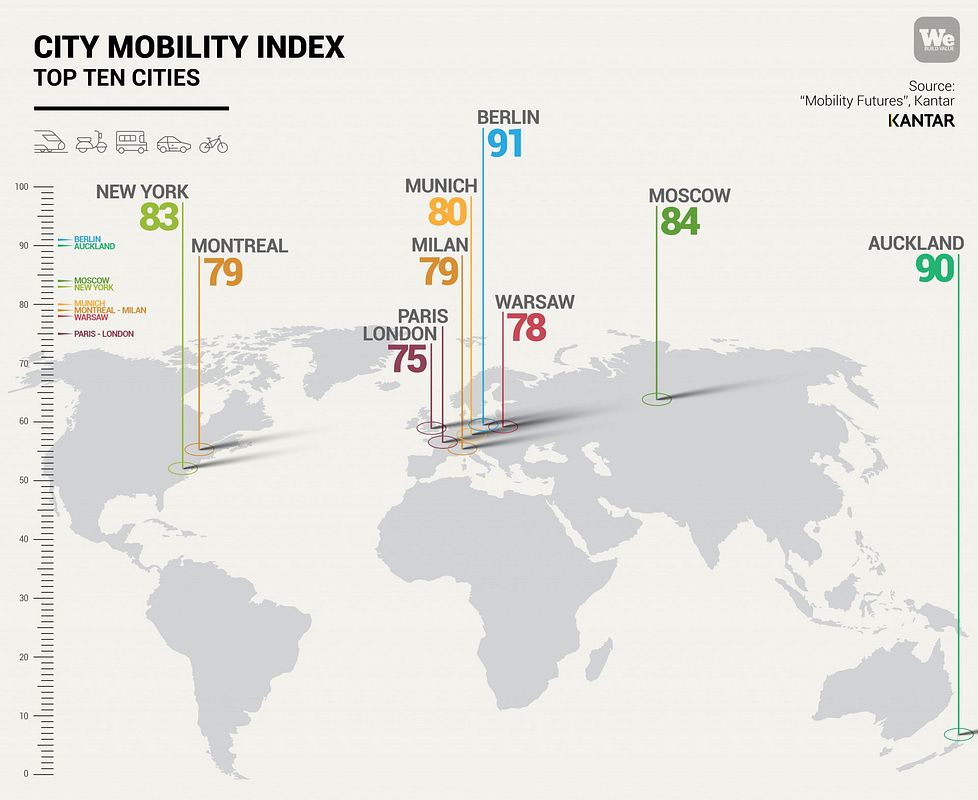How cities and people are driving positive changes in mobility… Will it be enough? Is Green Mobility Really on the Rise?
Entering the transition
Mobility – to be clear enough, our ways of getting from A to B – have an immense impact on the health of our planet and communities. Much is being discussed about green mobility, many measures are being taken. But what exactly are cities and their citizens – we – doing to improve what we call sustainable urban mobility?
Let’s briefly revisit why mobility is so crucial to sustainability: According to WWF, “Around one-quarter of global CO2 emissions come from the transportation of people and goods”. Moreover, the unsustainable transport emissions also impact people directly by polluting the air and congesting the roads.
Therefore, it is easy to recognise the need for shared solutions with lower carbon emissions.
Passing question: When you drive around town, how many people are in your car on average? Just you?
Maria Tsavachidis, CEO of the European Institute of Innovation and Technology on Urban Mobility, stated the following: “We cannot achieve the goals of a Sustainable and Smart Mobility Strategy without cities, they have to become a real actor in the innovation process from the very beginning instead of just being a stakeholder, and this for me is the game-changer in mobility.”
Naturally, public transport can serve as a starting point. Good, reliable and affordable public transportation modes (including busses, metros, trams, and others) are one key factor deciding how many people will be able and incentivised to use this sustainable transport.
In order to illustrate the possibilities, we can dive into examples of sustainable projects by cities.
Cities taking green actions
The City Mobility Index which focuses on highlights of urban transformation has a ranking of the top ten cities when it comes to green mobility. Starting off with the first place, Berlin is named the capital of sustainable mobility due to the promotion of new technologies which offer access to data and information concerning transport. Additionally, they focus on driverless subway lines and electric vehicles such as bikes.
Paris is also among the top ten and launched the construction of a Grand Paris Express, costing over €35 billion in total and covering around 200 km of underground lines. In the past, Paris’ mayors have already expanded the Metro system, lengthened the bicycle and bus lanes, as well as reduced parking availability. Moreover, they founded a city bike-sharing program called Vélib’ which later gave way to the electric car-pooling program of Autolib’.
City Mobility Index: Top ten cities of sustainable mobility
Other cities which have put in place green mobility measures but are not named in the index top ten include Jakarta. It was a pioneer in Asia for being the first city to build a Bus Rapid Transit (BRT) system in 2014 called Transjakarta. This is part of the city’s efforts in enhancing green mobility, along with building its metro to provide intermodular transport. Still, much more measures need to be taken to alleviate Jakarta’s congestion and pollution issues.
Another highly innovative solution is presented by the city of Odense in Denmark. When it rains, the intersections measure it, and cyclists will receive longer green lights to shorten their journey. This sensor also is connected to two motion detectors which let the system know when bikes are close to the intersection. Resulting from this, cyclists’ commutes are made easier to create incentives for choosing the bike.
Additionally, Coventry in the United Kingdom focusses on making alternatives to personal cars (including public transport, bikeshares, or taxis) more attractive by offering up to £3,000 in “mobility credits” which may be used on payments for the aforementioned modes.
What is needed? What would you need?
A common denominator for these greening cities is the investment in public transportation networks and encouraging a cultural shift from citizens using their cars alone every day, to sharing resources, carpooling or carsharing, biking or using public transport. Ultimately, however, the decision is up to us, the people: Whether we make use of the offered incentives and systems and choose to contribute to the green mobility transition.
And you, what would you need? Please, tell us!
15-minute cities
The 15-Minute City Project focuses on access within the urban transition, with the claim that “everyone living in a city should have access to essential urban services within a 15-minute walk or bike”. This idea, at its core, is about equality of opportunities: no member of a community should be (geographically) excluded from satisfying their basic needs using urban services. Naturally, the concept is far away from being feasible in many places of the world where there is a lack of infrastructure or transportation access. However, cities with the means should strive to fulfil this essential claim to ensure a green and efficient environment.
For more information on this project, you can read their blog here.
The key question here is how we are going to reconvert the big capitals into 15′ cities… Back to a village concept applied to the neighbourhoods?
A shared vision – and drawbacks
The desired outcome of this shift will be cities of a higher living standard, with cleaner air, roads, more cohesive communities, and lower carbon emissions.
But for this to happen, it needs long-term and collective action: governments, both national and regional, along with companies and citizens can each do their part to working towards this vision.
Lastly, different communities possess different resources and different natural foundations – this inevitably influences the availabilities for cities and their inhabitants. Nevertheless, within the varying boundaries, we are able to create change and hold our mayors accountable for their promises.
If you’re interested in mobility and sustainability, you should also read our other article on Individual, Societal and Urban Mobility.
Are you a member of the Komoneed community yet? If not, what are you waiting for? Join us and get regular insights on various sustainability topics!
Also, we want to hear your opinion…
- How do you personally commute? What are your reasons for your choice?
- What actions is your city taking, if any, to improve sustainable mobility?
- Which of the given city examples did you enjoy the most, or did you find the most surprising? Why?
Sources
- Sustainable mobility | WWF (panda.org)
- Sustainable mobility: top cities in the world – We Build Value
- 10 Examples of Green Mobility in Cities (stateofgreen.com)
- Five Cities that are Investing in Green Mobility | Data-Smart City Solutions (harvard.edu)
- Efficient and Green Mobility (europa.eu)
- Cities and the EU together for green mobility – Eurocities
- JAKARTA | WWF URBAN SOLUTIONS | WWF (panda.org)
- PARIS | WWF URBAN SOLUTIONS | WWF (panda.org)
- 15-Minute City (15minutecity.com)
- Berlin, Auckland and Moscow lead global mobility, study finds (kantar.com)






Right now, living in Berlin, I commute using mostly public transport, or by foot if I can. It’s very convenient & accessible. But in my hometown, I need to go by car, there is no good transport modes otherwise…
Probably, we are in a transition moment looking for different solutions in order to reduce pollution, from walking to hydrogen-cell cars.
WOW, the Denmark example is super cool! Very innovative it seems, and thoughtful to make it more comfortable to bike.
Thank Hanna! It’s true… Cool and innovative!
When I lived in Madrid, it was amazing to use public transport because the monthly card for young people is only 20€ – super affordable! Especially compared to London…
Yes! That’s great… and for people above 65 it’s free!
Great to see Jakarta’s initiative, but it’s sad to hear about the ongoing pollution issues etc… We really need more systematic change, on all fronts